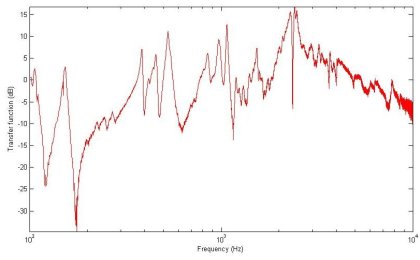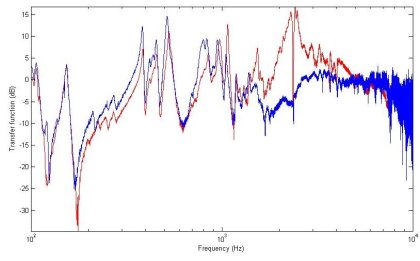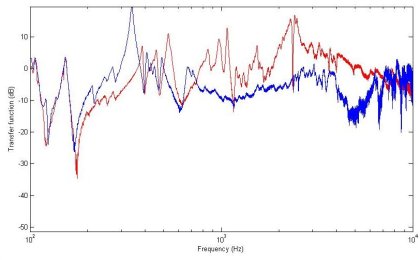Measurements on my violin
As part of my summer placement in the long vacation 2008, I was allowed to conduct some experiments to record the transfer function of my own violin. The technique is explained on this page, along with some details about ways in which we can use the information in our research.
In this experiment, my violin's response was measured to driving forces of all frequencies applied at the bridge. This tells me how my violin turns vibrations on the strings (caused by bowing or plucking them) into sounds which are heard by the listener. If we know the response function or admittance curve of the violin - how much it will respond to any frequency or pitch of vibration - we can calculate how the violin will react for any driving force on the bridge.

This graph shows the admittance curve for my violin.
To investigate this method of finding out about violin sounds, and to demonstrate the power of the technique, we decided to make some simple structural changes to my violin, and see what effect they had on the sound. I didn't want to change the position of the bridge, or damage my violin by trying to move things around, and so I simply used normal playing mutes to see what effect they had. Below are the two admittance curves which we obtained, plotted against the original curve in red:

Admittance curve of my violin, and admittance curve with a Heifitz mute (used when playing con sordino).

Admittance curve of my violin, and admittance curve with a prictice mute, which really deadens the sound.
As you can easily see, the curves are both different from the original admittance curve, and are also very different from each other. Both mutes add mass to the bridge, and it is not terribly surprising to note that the Heifitz mute acts as a low-pass filter, cutting out some of the violin's higher resonances, but does not change things all that much lower down in the register - the underlying 'violin-like' shape of the curve is still present, and easily recognized. However, the practice mute changes things a great deal, completely changing the normal admittance curve and cutting out a vast swathe of middle range frequencies. The violin, when played with this mute, no longer sounds characteristically like a violin. Note also that the practice mute has added a rather large resonance which was not present before, and this makes it more difficult to play notes which are near to this frequency.

